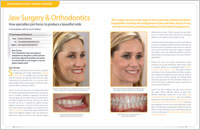In many cases, problems with the bite or the alignment of the teeth can be corrected using today’s advanced methods of dental and orthodontic treatment. Sometimes, however, skeletal and dental irregularities aren’t so easy to remedy, even with the most up-to-date non-surgical techniques. That’s when corrective jaw surgery (also called orthognathic surgery) may be recommended.
While it may sound like a complex and demanding treatment, jaw surgery isn’t always so serious. It’s often performed as a routine in-office procedure — for example, to extract impacted wisdom teeth (molars that don’t fully protrude through the gums), or to place dental implants in the jaw. However, it can also be used to remedy severe orthodontic problems involving the relationship between the teeth and jaws, including the correction of underbites (the most frequent surgical correction) and congenital abnormalities (birth defects) related to jaw development. It can even help alleviate sleep apnea, a potentially life-threatening condition.
Orthognathic surgery is always performed by an oral and maxillofacial surgeon, who spends four years in a hospital-based residency program after completing the standard four years of dental school. There, we dental surgeons train alongside other medical and surgical residents in areas like emergency medicine, general surgery, and anesthesiology. In fact, we are the only medical practitioners besides anesthesiologists who can administer all levels of sedation and general anesthesia.









